Reggae serves as a vital platform for social commentary, particularly in Canada, where it highlights the challenges faced by marginalized communities through impactful lyrics and engaging rhythms. The genre’s distinctive rhythmic patterns, characterized by offbeat accents and syncopation, contribute to its unique sound and laid-back groove. Additionally, reggae’s cultural roots are enriched by a blend of Jamaican traditions and local influences, resulting in a diverse musical expression that resonates with Canadian audiences.
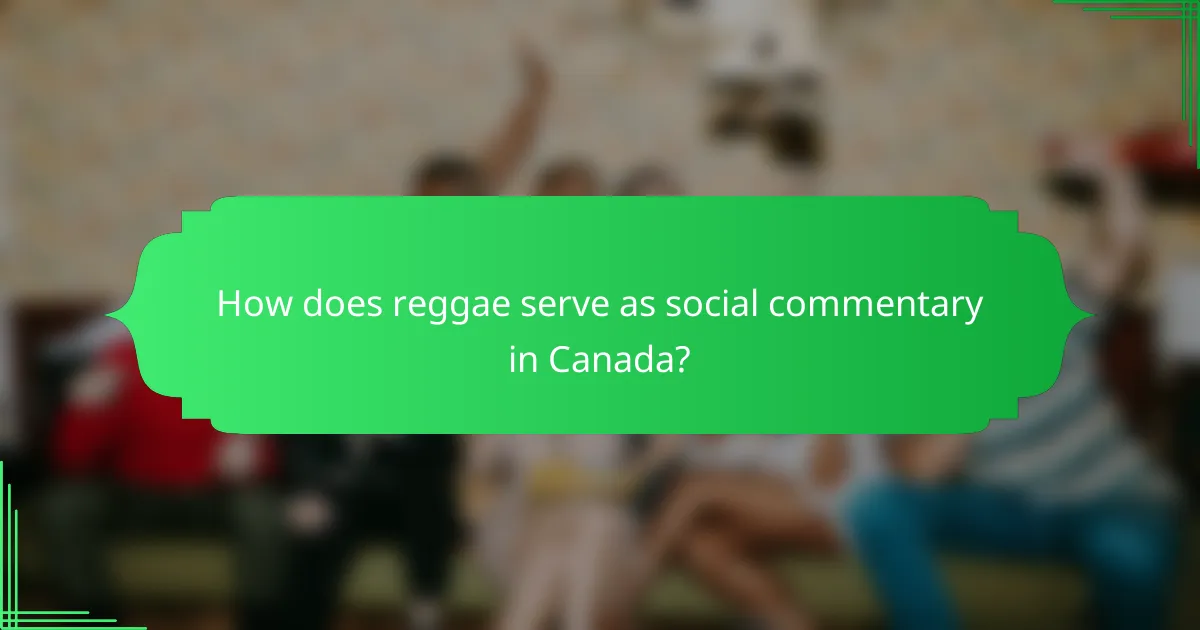
How does reggae serve as social commentary in Canada?
Reggae in Canada functions as a powerful medium for social commentary, reflecting the experiences and struggles of marginalized communities. Through its lyrics and rhythms, reggae artists address pressing social issues, fostering awareness and dialogue among listeners.
Addressing social issues
Reggae music often tackles social issues such as racism, poverty, and inequality. Canadian reggae artists use their platform to highlight the challenges faced by immigrant communities and Indigenous peoples, creating a connection between their music and the lived experiences of these groups.
For example, songs may discuss systemic discrimination or the impact of economic hardship, prompting listeners to reflect on these realities. This approach not only entertains but also educates audiences about social justice and activism.
Influence of Rastafarian beliefs
Rastafarian beliefs significantly shape the themes found in reggae music, emphasizing unity, peace, and resistance against oppression. In Canada, many reggae artists incorporate elements of Rastafarian philosophy, promoting messages of empowerment and cultural pride.
These beliefs often resonate with listeners, encouraging a sense of community and shared identity among those who face similar struggles. The use of symbols and language from Rastafarian culture further enriches the social commentary embedded in the music.
Impact on Canadian identity
Reggae has become an integral part of Canada’s multicultural landscape, influencing the national identity by promoting diversity and inclusion. The genre’s fusion with local musical styles has created a unique sound that reflects Canada’s rich cultural tapestry.
Through reggae, artists celebrate their heritage while inviting others to appreciate different cultures, fostering a sense of belonging. This cultural exchange helps to shape a more inclusive Canadian identity that values the contributions of all its communities.
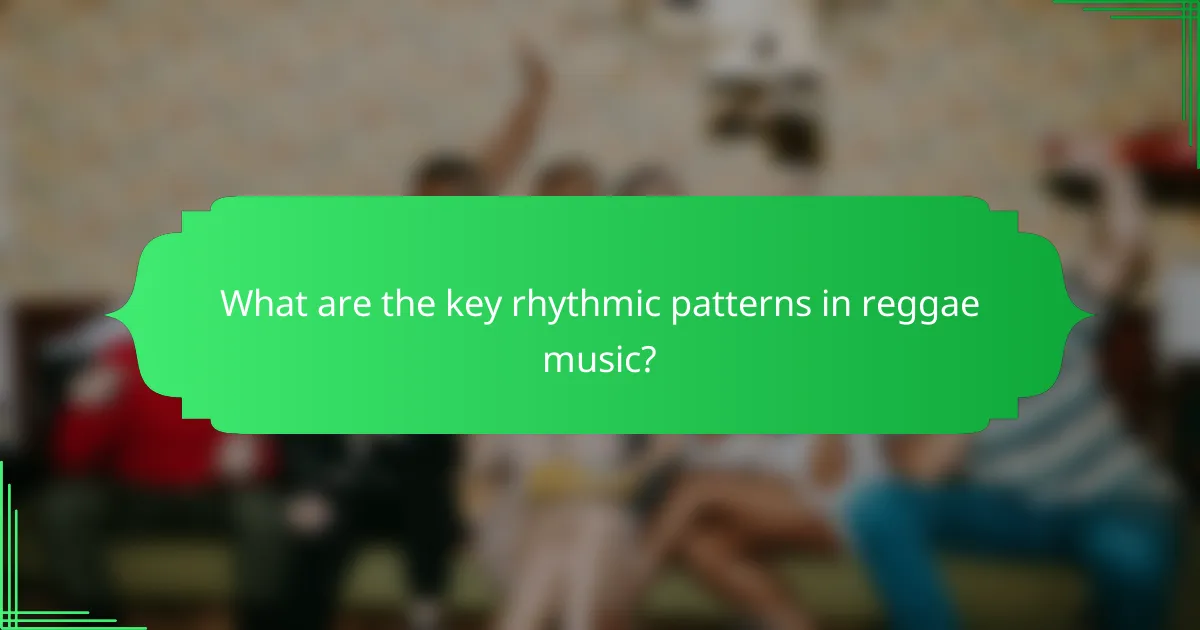
What are the key rhythmic patterns in reggae music?
The key rhythmic patterns in reggae music include distinct styles that define its unique sound. These patterns create a laid-back groove that is essential to reggae’s identity, often characterized by offbeat accents and syncopation.
One drop rhythm
The one drop rhythm is a foundational pattern in reggae, where the bass drum plays on the third beat of each measure. This creates a strong, steady pulse that emphasizes the offbeat, allowing the guitar and keyboard to accentuate the second and fourth beats. The result is a relaxed yet driving rhythm that is central to many classic reggae tracks.
In practice, the one drop rhythm often features a sparse arrangement, focusing on the bass and drums, which allows for a deep, resonant sound. Artists like Bob Marley frequently employed this rhythm, making it a staple in reggae music.
Steppers rhythm
The steppers rhythm is characterized by a steady bass drum beat on every quarter note, creating a more driving and energetic feel compared to the one drop. This pattern is often used in dancehall and roots reggae, providing a consistent pulse that supports faster tempos and more complex melodies. The bass line typically plays in sync with the kick drum, enhancing the overall groove.
Musicians often use the steppers rhythm to create a sense of urgency in their music, making it popular in live performances and dance settings. It’s effective for tracks that aim to get listeners moving and engaged.
Rockers rhythm
The rockers rhythm combines elements of both the one drop and steppers, featuring a kick drum that plays on the first and third beats while the snare emphasizes the backbeat. This creates a syncopated feel that is both laid-back and danceable, making it versatile for various reggae styles. The bass line often plays a prominent role, adding depth to the overall sound.
This rhythm is frequently used in classic reggae tracks and has influenced many genres beyond reggae, showcasing its adaptability. The rockers rhythm is ideal for songs that balance groove with lyrical content, allowing for both movement and message.

How do cultural roots influence reggae in Canada?
Cultural roots significantly shape reggae in Canada by blending Jamaican traditions with local influences. This fusion creates a unique sound that reflects the diverse backgrounds of Canadian artists and audiences.
Jamaican heritage
The foundation of reggae music in Canada is deeply rooted in Jamaican heritage. Artists often draw inspiration from the rhythms, themes, and social messages prevalent in traditional Jamaican reggae. This connection is evident in the use of the one drop rhythm and the incorporation of patois in lyrics.
Many Canadian reggae musicians have Jamaican ancestry, which allows them to maintain authentic cultural expressions while adapting to their Canadian environment. This heritage fosters a sense of community among artists and fans alike.
Indigenous influences
Indigenous cultures in Canada have also contributed to the reggae scene, introducing unique musical elements and storytelling traditions. Collaborations between Indigenous artists and reggae musicians often result in a rich blend of sounds that highlight social issues relevant to both communities.
These influences can be seen in the incorporation of traditional instruments and themes of resilience and connection to the land, which resonate with the core messages of reggae music.
Multiculturalism in Canadian reggae
Canada’s multicultural landscape plays a crucial role in the evolution of reggae music. Artists from various backgrounds contribute their own cultural elements, creating a diverse sound that reflects the nation’s identity. This blending of styles enriches the reggae genre and attracts a wider audience.
Events like music festivals and community gatherings often showcase this multiculturalism, where reggae serves as a platform for dialogue and celebration among different cultures. This inclusivity helps to strengthen the reggae community in Canada, making it a vibrant and dynamic scene.
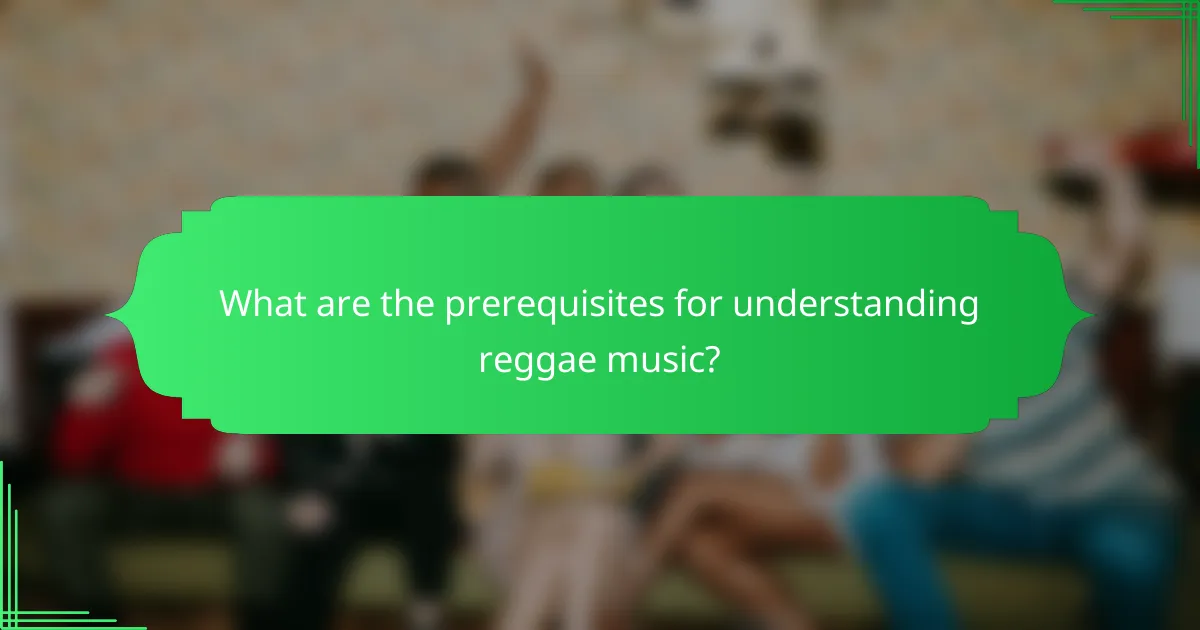
What are the prerequisites for understanding reggae music?
To understand reggae music, one should have a grasp of Jamaican history and some basic knowledge of musical theory. These elements provide context and enhance appreciation for the genre’s social commentary and rhythmic patterns.
Familiarity with Jamaican history
Understanding reggae music requires familiarity with Jamaican history, particularly the social and political issues that have influenced its development. Reggae emerged in the late 1960s, reflecting the struggles of the Jamaican people, including colonialism, poverty, and social injustice.
Key events, such as the Rastafarian movement and the influence of figures like Bob Marley, play a significant role in shaping reggae’s themes. Recognizing these historical contexts can deepen your appreciation for the lyrics and messages conveyed in reggae songs.
Knowledge of musical theory
A basic knowledge of musical theory is essential for grasping reggae’s unique rhythmic patterns and structures. Reggae typically features offbeat rhythms, known as the “one drop” style, where the emphasis is placed on the third beat of each measure.
Familiarity with terms like syncopation, tempo, and chord progressions can enhance your listening experience. Understanding these concepts allows you to appreciate the complexity of reggae music and its distinct sound compared to other genres.
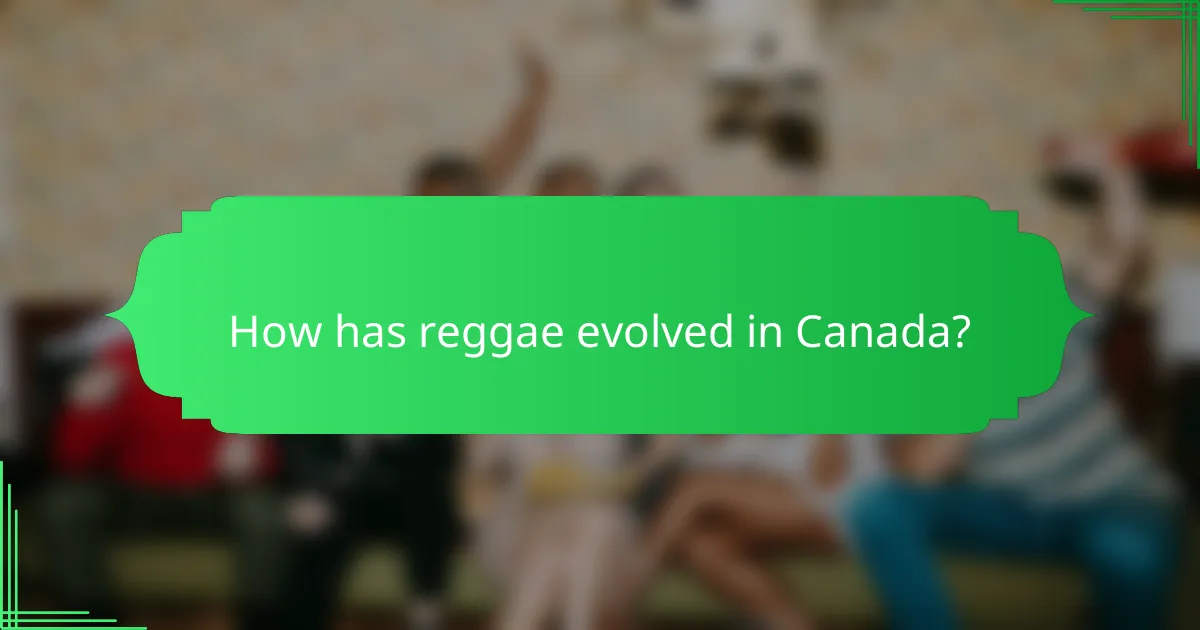
How has reggae evolved in Canada?
Reggae in Canada has evolved significantly, influenced by local culture and diverse musical styles. Canadian reggae artists have emerged, contributing to the genre’s growth while incorporating elements from their unique backgrounds.
Emergence of Canadian reggae artists
The emergence of Canadian reggae artists began in the late 20th century, with musicians like Messenjah and Dubmatix gaining recognition. These artists have brought a distinct Canadian flavor to reggae, often blending it with local influences and experiences.
Today, a new generation of Canadian reggae musicians continues to rise, showcasing their talents through various platforms. Festivals and local venues have become essential for promoting these artists, helping to solidify reggae’s presence in the Canadian music scene.
Fusion with other genres
Canadian reggae has increasingly fused with other genres, such as hip-hop, rock, and electronic music. This fusion creates a unique sound that resonates with a broader audience, allowing reggae to evolve while staying true to its roots.
Collaborations between reggae artists and musicians from different genres have become common, leading to innovative tracks that appeal to diverse listeners. This blending of styles not only enriches the reggae genre but also highlights the multicultural landscape of Canada.
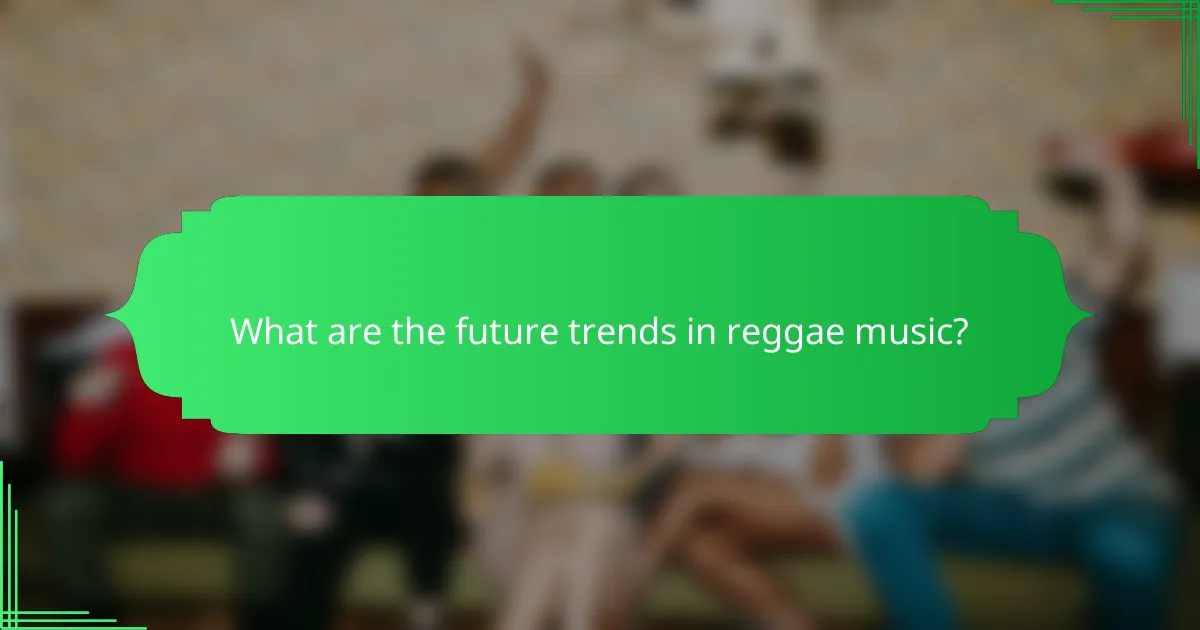
What are the future trends in reggae music?
Future trends in reggae music are increasingly shaped by digital distribution and global collaborations. As technology evolves, artists are finding new ways to reach audiences and work together across borders, enhancing the genre’s diversity and accessibility.
Digital distribution and streaming
Digital distribution and streaming platforms are revolutionizing how reggae music is consumed. Artists can now upload their tracks to platforms like Spotify and Apple Music, allowing for immediate global access. This shift has led to a significant increase in the audience base, especially among younger listeners who prefer streaming over traditional purchasing methods.
To maximize reach, reggae artists should focus on creating engaging content for social media and utilize playlist placements on streaming services. Collaborating with influencers or curators can also enhance visibility. However, artists must be aware of the revenue-sharing models, as streaming payouts can vary widely, often leading to lower earnings compared to physical sales.
Global collaborations
Global collaborations are becoming a hallmark of modern reggae music, blending traditional sounds with influences from various genres worldwide. Artists from different countries are increasingly teaming up, resulting in innovative fusions that appeal to diverse audiences. For example, reggae artists might collaborate with hip-hop or electronic musicians to create unique tracks that resonate across cultural lines.
These partnerships not only expand the musical landscape but also promote cultural exchange. Reggae artists should seek opportunities to collaborate with musicians from different backgrounds, as this can enhance creativity and broaden their fan base. However, it’s essential to approach these collaborations with respect for the cultural roots of reggae to maintain authenticity and integrity.
